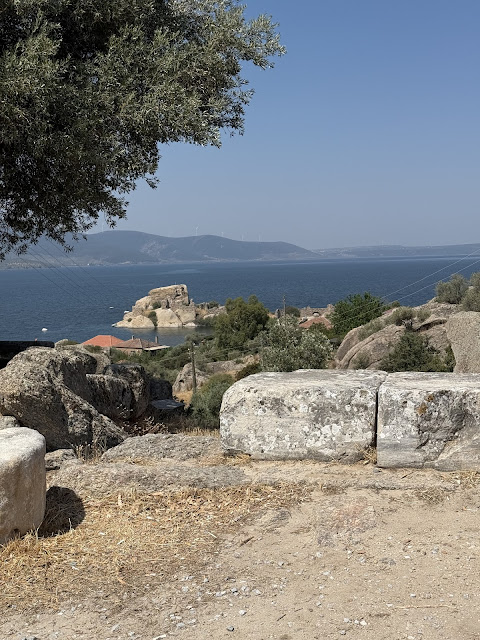Didim is a small harbor town where we anchored this morning. A ferryboat picked us up — along with around 40 of our fellow guests — and took us to the town dock where tour buses were waiting. Our destination, around an hour’s drive from the port, was the archaeology site of the ancient city of Herakleia, near Lake Bafa and at the foot of Mount Lamos. Ancient Greeks and Romans lived in the city, which later belonged to the Byzantine Empire. The disappearance of the population that once lived there is due to the silting up of the nearby lake, which in earlier times was a sea port. Afterwards, for some years, the lake provided a large catch of eels, which were caught, smoked, and canned for export, but this industry too has become unfeasible because silt and algae have built up in the water.
 |
| Ancient stones at Herakleia. |
Only a tiny village still exists at the site of Herakleia. We made a stop at the town’s one cafe, where we encountered several women from the village. They were wearing head scarves, plaid shirts, and brightly printed pants, and aggressively selling beaded kerchiefs and other handicrafts. We sampled the local drink made from yogurt, salt, and ice water. The two buses from our ship were the only visitors this morning. So different from yesterday!
Another ancient Greek city, Miletus, also in this area, was home to several famous ancient Greek philosophers including Anaximenes and Thales. Miletus is on the schedule for this afternoon, but because it’s extremely hot today (over 100°F) we decided to stay on the ship.
The other people from our ship this morning made a tour of the Herakleia site. It was led by the archaeologist/professor who is currently excavating the site and several students from the University of Kansas. Meanwhile, Len and I requested a different activity: we went on a bird walk near the lake with one of the local guides and one other birder, who happens to be the ship’s doctor. Obviously, we wished we could have been there at 5 AM for optimal birding. However, we did see a few nice birds, especially some herons, egrets, and cormorants, and one lone flamingo.
 |
| Len’s photo of the flamingo, which is white. (You may know that flamingos get their color from the food they eat, so I guess this one does not eat shrimp) |
Photos © 2025 mae and len sander



13 comments:
That Byzantine fortress photo -- should be framed big. It's fantastic. What a remarkable journey.
I LOVE all of these photos!
Well, you have memories to last. This is amazing.
I love especially the lighthouse.
Spotting a white flamingo sounds absolutely amazing. Great way to make the most of a hot day in Didim!
Hello Mae,
What a beautiful place to explore and look for birds.
I love the lighthouse, the water views, fortress and the flamingo.
Thanks so much for linking up and sharing your critter post! Take care, have a great weekend. PS, thank you for leaving me a comment.
I would have chosen the bird walk too, but it didn’t yield much. As you say an earlier start would have been greatly preferable.
What a fabulous place to visit! And I love the sights on your walk. The flamingo was beautiful! Hugs!
We are hoping to get to Turkiye next year! Fingers crossed!
I've never thought about going to Turkey---the language intimidates me---but I can see the delight you have in exploring this world. How wonderful that you got to go on a bird tour there. Hope you are able to see all you want to see and that the heat is not too daunting.
Gorgeous photos!
A beautiful place to explore and create memories.
I love seeing your travels since I am doing much less international travel these days (not for want of going, of course). Thank you for posting about it all.
Post a Comment